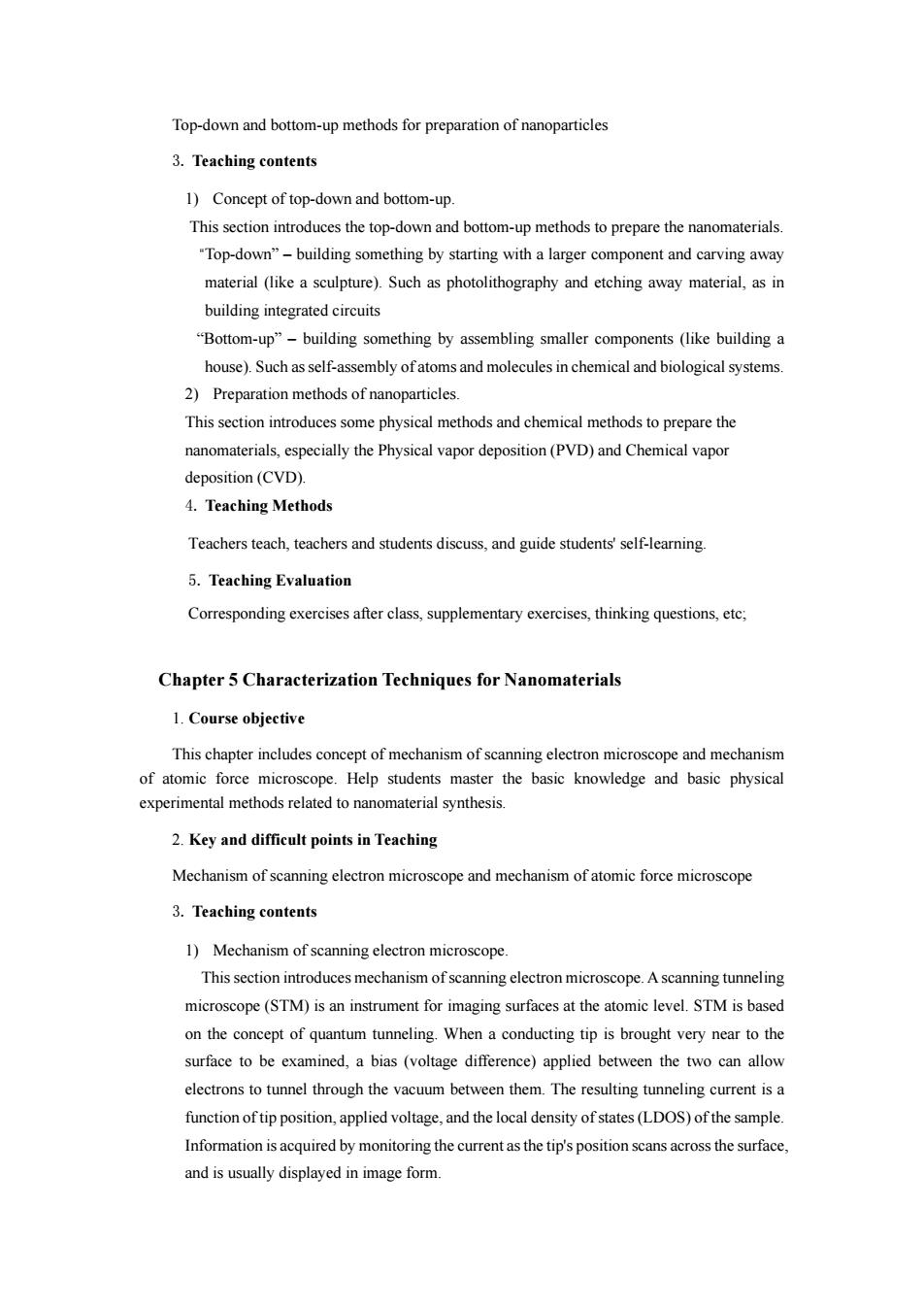正在加载图片...

Top-down and bottom-up methods for preparation of nanoparticles 3.Teaching contents 1)Concept of top-down and bottom-up. This section introduces the top-down and bottom-up methods toprepare the nanomaterials "Top-down"-building something by starting with a larger component and carving away material (like a sculpture).Such as photolithography and etching away material,as in building integrated circuits "Bottom-up"-building something by assembling smaller components(like building a house).Such as self-assembly of atoms and molecules in chemical and biological systems. 2)Preparation methods of nanoparticles This section introduces some physical methods and chemical methods to prepare the nanomaterials,especilly the Physical vapor deposition(PVD)and Chemical vapor deposition (CVD) 4.Teaching Methods Teachers teach,teachers and students discuss,and guide students'self-learning. 5.Teaching Evaluation Corresponding exercises after class.supplementary exercises,thinking questions.etc. Chapter 5 Characterization Techniques for Nanomaterials 1.Course objective This chapter includes concept of mechanism of scanning electron microscope and mechanism of atomic force microscope.Help students master the basic knowledge and basic physical experimental methods related tonanomaterial synthesis 2.Key and difficult points in Teaching Mechanism of scanning electron microscope and mechanism of atomic force microscope 3.Teaching contents 1)Mechanism of scanning electron microscope. This section introduces mechanism of scanning electron microscope.A scanning tunneling microscope(STM)is an instrument for imaging surfaces at the atomic level.STM is based on the concept of quantum tunneling.When a conducting tip is brought very near to the surface to be examined,a bias (voltage difference)applied between the two can allow electrons to tunnel through the vacuum between them.The resulting tunneling current is a function oftip position,applied voltage,and the local density of states(LDOS)of the sample Information is acquired by monitoring the current as the tip's position scans across the surface. and is usually displayed in image formTop-down and bottom-up methods for preparation of nanoparticles 3. Teaching contents 1) Concept of top-down and bottom-up. This section introduces the top-down and bottom-up methods to prepare the nanomaterials. “Top-down” – building something by starting with a larger component and carving away material (like a sculpture). Such as photolithography and etching away material, as in building integrated circuits “Bottom-up” – building something by assembling smaller components (like building a house). Such as self-assembly of atoms and molecules in chemical and biological systems. 2) Preparation methods of nanoparticles. This section introduces some physical methods and chemical methods to prepare the nanomaterials, especially the Physical vapor deposition (PVD) and Chemical vapor deposition (CVD). 4. Teaching Methods Teachers teach, teachers and students discuss, and guide students' self-learning. 5. Teaching Evaluation Corresponding exercises after class, supplementary exercises, thinking questions, etc; Chapter 5 Characterization Techniques for Nanomaterials 1. Course objective This chapter includes concept of mechanism of scanning electron microscope and mechanism of atomic force microscope. Help students master the basic knowledge and basic physical experimental methods related to nanomaterial synthesis. 2. Key and difficult points in Teaching Mechanism of scanning electron microscope and mechanism of atomic force microscope 3. Teaching contents 1) Mechanism of scanning electron microscope. This section introduces mechanism of scanning electron microscope. A scanning tunneling microscope (STM) is an instrument for imaging surfaces at the atomic level. STM is based on the concept of quantum tunneling. When a conducting tip is brought very near to the surface to be examined, a bias (voltage difference) applied between the two can allow electrons to tunnel through the vacuum between them. The resulting tunneling current is a function of tip position, applied voltage, and the local density of states (LDOS) of the sample. Information is acquired by monitoring the current as the tip's position scans across the surface, and is usually displayed in image form